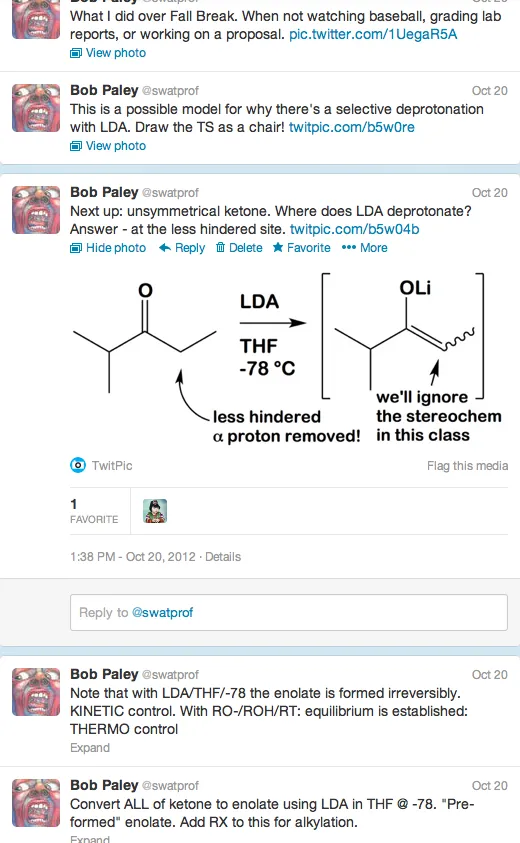#Chem32 @Twitter
This past fall, Professor Bob Paley decided to experiment on his Organic Chemistry II class. Before you worry: this did not involve dousing post-Pub Night students with potassium permanganate and acid to see if they sprouted carboxyls. Rather, this experiment focused on education and technology. "I had decided that I was going to try an experiment and to see if I could augment my lectures with Twitter", Paley explained. "I figured oh, new technology - students are going to be completely up-to-date on that - so I figured I'd give it a try."
Twitter was not to be used as an interactive tool during class, but instead as a supplement to remind students of chemistry outside of the Monday-Wednesday-Friday lectures. Paley would send out tweets that either re-emphasized an important point from lecture or previewed a topic to come. These tweets would also occasionally include TwitPics of a reaction/molecule hand-crafted in ChemDraw, a picture of his research, or the results of his student research assistants. In addition, students were able to tweet questions to Paley. This, as Paley remarked, not only allowed everyone (at least everyone following the Twitter) to see the question and answer, but also offered convenience: "you could send [the question] at 3 in the morning and I'll answer at 8!"
Methodology
Before last summer, Paley had never used Twitter before, even for personal use, but he wanted to try a new way to reach his students via technology. He chose Twitter over other forms of electronic communication and social media for a few reasons. Facebook was too inappropriate for an academic setting, mostly because of the amount of personal information shared with "friends". Email, on the other hand, was far too impersonal and didn't utilize any "cool", new technology. And finally, the discussion boards on Moodle seemed too inconvenient and had the potential to evolve into grumble forums.
He also admits that he is still mastering its ins-and-outs of Twitter. The 140 character limit can be quite a challenge, especially since chemistry is rife with long molecule and reaction names. He was able to use a few of his abbreviations from class - such as LG for 'leaving group', ROH for 'alcohol', and Nuc for 'nucleophile' - but, as he pointed out, "precision is important in science...you can't always call molecules 'things' or 'this guy', that's inappropriate. You have to use the name. You just have to find a way to make it terse". And while he has figured out ways to cram his point into 140 characters, he still must remind himself to incorporate hashtags, which are one of the less intuitive parts of tweeting. He laughed, "I think once I wrote #aldol, and actually I looked, and there were other people who had written about the aldol. Mostly it was former students [complaining] about having to learn about the aldol reaction... Apparently there's a hashtag #RealTimeChem, which I haven't used. But now I know that it exists".
One other facet of Twitter that he is still working on is the retweet. When asked if he ever retweets other chemists or science news, he explained, "Well, I don't really follow science-y people. I should do that; that would be a good thing to do. It wasn't like I hadn't thought about that, but I was figuring out that kind of stuff as I was going along and I just never got that far".
Results
Initially, Paley was hopeful about the effectiveness of Twitter in the course. He recounted with a smile that, after pointing his Twitter out on the syllabus in class, "the feedback I heard was 'oh, cool, he uses Twitter; he's on Twitter' and so I thought: this is going to be an experiment that is going to totally work". However, despite the excited whispers on the first day of class, only about 20% of the class actually ended up interacting with or following him on Twitter.
He noted that a surprisingly small number of students - only 3 or 4 - actually owned a Twitter account to begin with. "I nudged the students to get a Twitter account and a lot of them did... There [were] a couple of students who were absolutely resistant to the idea - but I would say that most of the students got one. Now, whether they got into the habit of actually checking it or not, I have no idea".
Discussion
Although his use of Twitter this year did not generate an overwhelming response, he resolves to try it again in the future, especially since the retweet feature will allow him to re-use some of the same material. "Whether it evolves over time, I'll have to see how that goes... If more and more students get involved with it, then it's worth it. It's fun also".
And Paley candidly pointed out, the low-turn out didn't necessarily imply a failure: "For the most part, my goal was just to sort of fill in the gaps...so the students at least think for those 20 seconds about chemistry outside the classroom. If I stimulated some neurons doing that, well, that would be awesome."
To follow Paley on Twitter, check out @SwatProf.

Written by Allie Goldberg '11.



